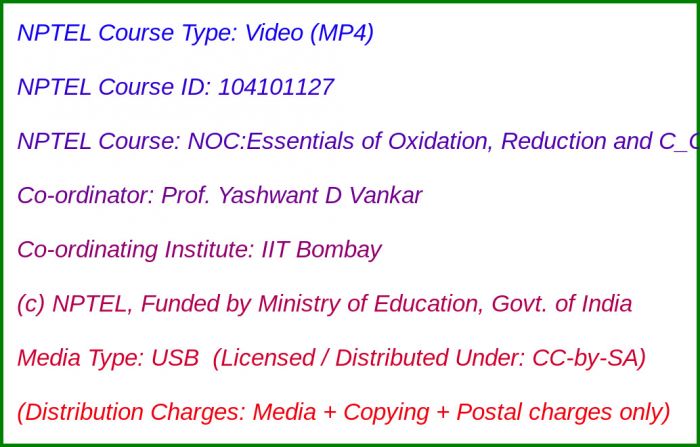NOC:Essentials of Oxidation, Reduction and C_C Bond Formation. Application in Organic Synthesis

Media Storage Type : 32 GB USB Stick
NPTEL Subject Matter Expert : Prof. Yashwant D Vankar
NPTEL Co-ordinating Institute : IIT Bombay
NPTEL Lecture Count : 60
NPTEL Course Size : 5.1 GB
NPTEL PDF Text Transcription : Available and Included
NPTEL Subtitle Transcription : Available and Included (SRT)
Lecture Titles:
Lecture 1 - Introduction to organic synthesis-Importance of selectivity, stereochemistry and Mechanism
Lecture 2 - Sulfur based oxidations of alcohols
Lecture 3 - Sulfur based oxidations and Pummerer rearrangement
Lecture 4 - Further aspects of sulfur and selenium based oxidations
Lecture 5 - Organoselenium chemistry and SeO2 based oxidations
Lecture 6 - SeO2 based oxidation of ketones and Sulfoxide- Sulfenate rearrangement (Mislow-Evans rearrangement)
Lecture 7 - Mechanistic and stereochemical aspects of Mislow-Evans rearrangement and synthetic applications
Lecture 8 - Further synthetic applications of Mislow-Evans rearrangement and Saegusa-Ito oxidation
Lecture 9 - 1,2-Ketone transpositions, Shapiro reaction and Dauben-Michno rearrangement (a case of 1,3-enone transposition)
Lecture 10 - Dess-Martin periodinane oxidation
Lecture 11 - Iodoxybenzoic acid (IBX) based oxidations
Lecture 12 - Silver based oxidations: Prevost reaction and use of Fetizon’s reagent
Lecture 13 - Further aspects of oxidations using Fetizon’s reagent: Mechanism and Stereochemistry
Lecture 14 - Ruthenium tetroxide (and RuCl3/NaIO4) mediated oxidations
Lecture 15 - Tetra-n-propylammonium perruthenate (TPAP) based oxidations, and Tamao-Fleming oxidation
Lecture 16 - Further synthetic and mechanistic aspects of Tamao-Fleming oxidations
Lecture 17 - Oxidations with dimethyl dioxirane (DMDO)
Lecture 18 - Mechanistic aspects of DMDO based oxidations and oxaziridine mediated alpha-hydroxylations of ketones
Lecture 19 - Asymmetric alpha-hydroxylations using oxaziridine based reactions
Lecture 20 - Barton and related reactions (oxidation at unfunctionalised carbons) and synthetic applications
Lecture 21 - beta-Cleavage in Barton and related reactions and miscellaneous oxidations such as TEMPO based oxidations, Pinnick oxidation and pseudomonas putida mediated oxidations
Lecture 22 - Reductions in organic chemistry: Metal hydride (NaBH4 and LiAlH4) mediated reduction
Lecture 23 - Reductions using diisobutylaluminum hydride (DIBAL-H)
Lecture 24 - Further aspects of DIBAL-H based reductions and comparison with mixed chloride hydrides
Lecture 25 - Reductions with Red-Al, and Luche Reductions
Lecture 26 - Further aspects of Luche reduction, stereochemistry in reductions and reduction with LiBH4
Lecture 27 - Reductions with Zn(BH4)2, LiBHEt3 (superhydride) and L and K-selectrides
Lecture 28 - Reductions with LS/KS selectrides and NaCNBH3
Lecture 29 - Dissolving metal reductions (Na, K, Mg) and McMurry coupling using Ti(0)
Lecture 30 - Stereochemistry and mechanistic aspects of McMurry coupling and metal mediated reductions of alpha, beta-unsaturated ketones
Lecture 31 - Silanes [R3SiH, including polymethylhydrosiloxanes (PMHS)] as reducing agents
Lecture 32 - Further aspects of silanes as reducing agents and Barton-McCombie deoxygenation
Lecture 33 - Tributyltinhydride (n-Bu3SnH) based radical based reductions and C-C bond formations
Lecture 34 - Asymmetric synthesis: An introduction
Lecture 35 - Sharpless asymmetric epoxidation: Mechanism, stereochemistry and kinetic resolution
Lecture 36 - Synthetic utility of chiral 2,3-epoxy alcohols obtained from Sharpless epoxidation
Lecture 37 - Katsuki-Jacobsen epoxidation: Mechanism and stereochemistry
Lecture 38 - Further aspects of Katsuki-Jacobsen epoxidation, and Introduction to Sharpless Asymmetric Dihydroxylation
Lecture 39 - Mechanism, stereochemical aspects and synthetic applications of Sharpless Asymmetric Dihydroxylation
Lecture 40 - Asymmetric hydrogenations and reductions using rhodium and ruthenium derived chiral catalysts
Lecture 41 - Asymmetric reduction with oxazaborilidines
Lecture 42 - C-C bond formations: Introduction to enolate, enamine and enol silyl ether based chemistry
Lecture 43 - C-C bond formations using enol silyl ether and imine based chemistry including SAMP and RAMP based asymmetric alkylations
Lecture 44 - Asymmetric C-C bond formations using Oppolzer’s camphorsultams and introduction to directed Aldol reactions
Lecture 45 - Further aspects of Aldol chemistry including the use of boron and silicon enolates
Lecture 46 - C-C bond formations using Evans’ oxazolidinone based chemistry
Lecture 47 - Ireland-Claisen rearrangement: Emphasis of enolate geometry on the stereochemical outcome, and Claisen rearrangements
Lecture 48 - Aromatic Claisen rearrangement, Johnson-Claisen rearrangement and Eschenmoser-Claisen rearrangement and synthetic
Lecture 49 - Bellus-Claisen rearrangement, Aza-Claisen rearrangement, Thia-Claisen rearrangement, Chen-Mapp rearrangement and their synthetic applications
Lecture 50 - Zwitterionic-Claisen rearrangement, Overmann rearrangement, Bamford- Stevens and Shapiro reactions and synthetic applications
Lecture 51 - Introduction to allyl metal additions for C-C bond formation
Lecture 52 - Allylindium chemistry: Mechanism, stereochemistry and synthetic applications
Lecture 53 - Allyltin chemistry: Mechanism, stereochemistry and synthetic applications
Lecture 54 - Chemistry of allylsilanes: Mechanism, stereochemistry and synthetic applications - Part 1
Lecture 55 - Further synthetic aspects of the chemistry of allylsilanes - Part 2
Lecture 56 - Further synthetic aspects of the chemistry of allylsilanes - Part 3
Lecture 57 - Chemistry of Vinylsilanes: Mechanism, Stereochemistry and Synthetic Applications
Lecture 58 - Peterson olefination and further synthetic aspects of vinylsilane chemistry
Lecture 59 - Simmons Smith cyclopropanation: Mechanism, stereochemistry and synthetic applications
Lecture 60 - Course Summary and Conclusion

